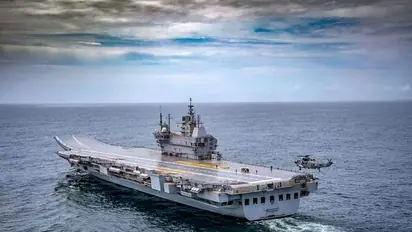Indigenous Aircraft Carrier Vikrant: The journey from steel to ship

Synopsis
The ceremonial Steel Cutting for the IAC Vikrant began in April 2005. According to the Navy, the Steel Authority of India Limited (SAIL) indigenised the warship-grade steel required for the IAC-1's construction in collaboration with the Defence Research and Development Laboratory (DRDL) and the Indian Navy.
Prime Minister Narendra Modi commissioned India's first indigenous aircraft carrier, INS Vikrant, on Friday, September 2. The PM commissioned the largest ship ever built in the country's maritime history at the Cochin Shipyard. The main arsenal of INS Vikrant is the Russian-origin MiG-29K, a naval version of the MiG-29 jet that has served with the Indian Air Force for decades.
As India receives its first indigenous aircraft carrier, let's understand the indigenous components of the new 'Vikrant'.
1) The IAC Vikrant's construction began in April 2005 with the ceremonial Steel Cutting. Steel Authority of India Limited (SAIL) indigenised the warship-grade steel required for the IAC-1's construction in collaboration with Defence Research & Development Laboratory (DRDL) and the Indian Navy, according to the Navy. According to the report, one of the major benefits of developing the indigenous aircraft carrier was that the country became self-sufficient in warship steel.
2) According to the Navy, the project's indigenous content is approximately 76 per cent. This includes 23,000 tonnes of steel, 2,500 kilometres of electric cable, 150 kilometres of pipes, 2,000 valves, and various finished products such as rigid hull boats, galley equipment, air-conditioning and refrigeration plants, and steering gear.
3) According to the official release, major Indian industrial houses, including BEL, BHEL, GRSE, Keltron, Kirloskar, L&T, Wartsila India, and over 100 MSMEs, contributed to the development of indigenous equipment and machinery on board. According to the release, the indigenisation efforts resulted in the development of ancillary industries and the creation of employment opportunities for 2,000 CSL personnel and approximately 13,000 employees in ancillary industries, thereby bolstering the plough-back effect on the nation's economy.
4) The Navy previously stated that more than 50 Indian manufacturers were directly involved in the project and that approximately 2,000 Indians were directly employed on board IAC-1 daily. Over 40,000 people were indirectly employed.
5) The keel of the warship was laid in February 2009, and the first construction phase was completed in August 2013 by Cochin Shipyard Limited.
6) The Indian Navy's Warship Design Bureau (WDB) created the design for the warship, which PSU Cochin Shipyard Limited built.
7) The Navy stated that approximately 80-85 per cent of the project cost of nearly Rs 23,000 crore was invested back into the Indian economy. Modern automation elements were installed in the ship at a price of Rs 20,000 crore by Cochin Shipyard Limited.
8) On July 8, 2022, Cochin Shipyard Limited delivered the newly constructed ship to the Indian Navy.
The commissioning of the INS Vikrant is a historic moment in India's journey toward defence self-sufficiency. India has now joined a select group of countries, including the United States, the United Kingdom, Russia, China, and France, that have the capability and might to design and build an aircraft carrier in-house.
The ship can house up to 30 aircraft. The warship will initially operate MiG-29K fighter jets, Kamov-31, and MH-60R multi-role helicopters, and indigenously developed Advanced Light Helicopters (ALH) and Light Combat Aircraft (LCA).
Also Read: Words won't describe... PM recalls feeling proud on board INS Vikrant
Also Read: Vikrant not just a warship... It is India's answer to obstacles: PM
Also Read: First 'swadeshi' aircraft carrier Vikrant made of special steel
Stay updated with the Breaking News Today and Latest News from across India and around the world. Get real-time updates, in-depth analysis, and comprehensive coverage of India News, World News, Indian Defence News, Kerala News, and Karnataka News. From politics to current affairs, follow every major story as it unfolds. Download the Asianet News Official App to stay informed anytime, anywhere.